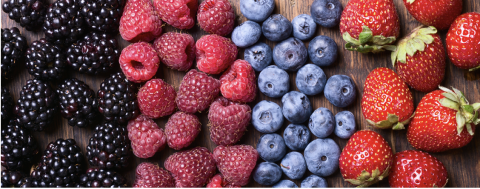P0663
Freezing Fruits

Download the PDF above for the complete publication.
You can freeze most fruits, but the quality of the frozen product depends on the kind of fruit, stage of maturity, and type of pack.
- Select firm, evenly ripe fruit of the right variety for freezing. Freeze fruit that has a good flavor and color and is at peak ripeness for eating. Freezing won’t improve the quality of the fruit. Immature fruit becomes pale and tasteless in the freezer; overripe fruit turns dark.
- Most fruits are best when frozen soon after they are harvested. Peaches and pears may be held a short time to ripen.
- Wash fruit in cold water before hulling or paring. Wash a small amount at one time to prevent bruising. Don’t let fruit soak in water. Prepare as for serving. Use a stainless steel knife for paring or cutting. Work quickly. Slice fruit directly into the carton containing syrup, or immediately add sugar to the fruit.
- Fruits packed with dry sugar or sugar syrup usually retain their color, flavor, and texture better than those packed without sugar. The amount of sugar or syrup used depends on the sweetness desired. Juicy fruits will make their own syrup when combined with dry sugar. You may want to use sugar syrup for less juicy fruits.
- Some fruits darken during freezing if you don’t treat them to prevent browning. Speed is important in preparing fruit for freezing. Ascorbic acid (vitamin C) is effective in preserving the color and flavor of fruit and adds nutritive value. It also adds to the expense of freezing fruits. A crystalline or powdered form of ascorbic acid is easier and better to use than tablets. Dissolve ascorbic acid in a little cold water and add it to the fruit or syrup. Make solutions as needed. If you use one of the ascorbic acid mixtures on the market, follow the manufacturer’s directions. Steaming a few minutes before packing is enough to control the darkening of some fruits, such as apples. You can use citric acid or lemon juice on some fruits, but it is less effective than ascorbic acid and changes the flavor of the fruit.
- Use a package that protects the quality of the fruit while in storage. Select the size container according to your planned use of the fruit.
- Leave head space in the container as directed for each fruit.
- Seal the container and label it with the name of the fruit, the date, the purpose for which the fruit is intended (such as pie, jam, or dessert), and the amount of sugar used in the pack.
- Freeze immediately. Place packages against freezing plates or coils. Leave space between packages so air can circulate freely.
This publication provides freezing/packing tips for the following:
- Apples
- Applesauce
- Blackberries, boysenberries, and dewberries
- Blueberries and huckleberries
- Coconut
- Figs
- Grapes
- Melons
- Peaches
- Pears
- Pecans
- Plums and prunes
- Raspberries
- Rhubarb
- Strawberries
You can also contact state Extension specialists or your local Extension office for answers to specific questions.
Publication 663 (POD-07-25)
Reviewed by Courtney Crist, PhD, Associate Extension Professor, Biochemistry, Nutrition, and Health Promotion.
The Mississippi State University Extension Service is working to ensure all web content is accessible to all users. If you need assistance accessing any of our content, please email the webteam or call 662-325-2262.
